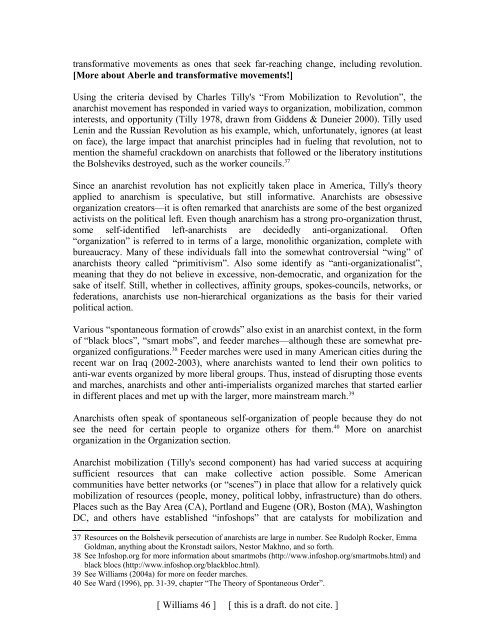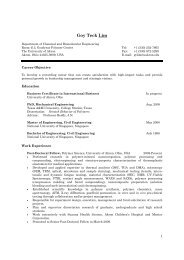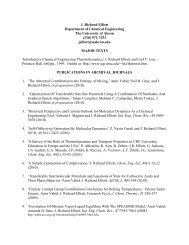Sociology of the Anarchists - Gozips.uakron.edu - The University of ...
Sociology of the Anarchists - Gozips.uakron.edu - The University of ...
Sociology of the Anarchists - Gozips.uakron.edu - The University of ...
Create successful ePaper yourself
Turn your PDF publications into a flip-book with our unique Google optimized e-Paper software.
transformative movements as ones that seek far-reaching change, including revolution.<br />
[More about Aberle and transformative movements!]<br />
Using <strong>the</strong> criteria devised by Charles Tilly's “From Mobilization to Revolution”, <strong>the</strong><br />
anarchist movement has responded in varied ways to organization, mobilization, common<br />
interests, and opportunity (Tilly 1978, drawn from Giddens & Duneier 2000). Tilly used<br />
Lenin and <strong>the</strong> Russian Revolution as his example, which, unfortunately, ignores (at least<br />
on face), <strong>the</strong> large impact that anarchist principles had in fueling that revolution, not to<br />
mention <strong>the</strong> shameful crackdown on anarchists that followed or <strong>the</strong> liberatory institutions<br />
<strong>the</strong> Bolsheviks destroyed, such as <strong>the</strong> worker councils. 37<br />
Since an anarchist revolution has not explicitly taken place in America, Tilly's <strong>the</strong>ory<br />
applied to anarchism is speculative, but still informative. <strong>Anarchists</strong> are obsessive<br />
organization creators—it is <strong>of</strong>ten remarked that anarchists are some <strong>of</strong> <strong>the</strong> best organized<br />
activists on <strong>the</strong> political left. Even though anarchism has a strong pro-organization thrust,<br />
some self-identified left-anarchists are decidedly anti-organizational. Often<br />
“organization” is referred to in terms <strong>of</strong> a large, monolithic organization, complete with<br />
bureaucracy. Many <strong>of</strong> <strong>the</strong>se individuals fall into <strong>the</strong> somewhat controversial “wing” <strong>of</strong><br />
anarchists <strong>the</strong>ory called “primitivism”. Also some identify as “anti-organizationalist”,<br />
meaning that <strong>the</strong>y do not believe in excessive, non-democratic, and organization for <strong>the</strong><br />
sake <strong>of</strong> itself. Still, whe<strong>the</strong>r in collectives, affinity groups, spokes-councils, networks, or<br />
federations, anarchists use non-hierarchical organizations as <strong>the</strong> basis for <strong>the</strong>ir varied<br />
political action.<br />
Various “spontaneous formation <strong>of</strong> crowds” also exist in an anarchist context, in <strong>the</strong> form<br />
<strong>of</strong> “black blocs”, “smart mobs”, and feeder marches—although <strong>the</strong>se are somewhat preorganized<br />
configurations. 38 Feeder marches were used in many American cities during <strong>the</strong><br />
recent war on Iraq (2002-2003), where anarchists wanted to lend <strong>the</strong>ir own politics to<br />
anti-war events organized by more liberal groups. Thus, instead <strong>of</strong> disrupting those events<br />
and marches, anarchists and o<strong>the</strong>r anti-imperialists organized marches that started earlier<br />
in different places and met up with <strong>the</strong> larger, more mainstream march. 39<br />
<strong>Anarchists</strong> <strong>of</strong>ten speak <strong>of</strong> spontaneous self-organization <strong>of</strong> people because <strong>the</strong>y do not<br />
see <strong>the</strong> need for certain people to organize o<strong>the</strong>rs for <strong>the</strong>m. 40 More on anarchist<br />
organization in <strong>the</strong> Organization section.<br />
Anarchist mobilization (Tilly's second component) has had varied success at acquiring<br />
sufficient resources that can make collective action possible. Some American<br />
communities have better networks (or “scenes”) in place that allow for a relatively quick<br />
mobilization <strong>of</strong> resources (people, money, political lobby, infrastructure) than do o<strong>the</strong>rs.<br />
Places such as <strong>the</strong> Bay Area (CA), Portland and Eugene (OR), Boston (MA), Washington<br />
DC, and o<strong>the</strong>rs have established “infoshops” that are catalysts for mobilization and<br />
37 Resources on <strong>the</strong> Bolshevik persecution <strong>of</strong> anarchists are large in number. See Rudolph Rocker, Emma<br />
Goldman, anything about <strong>the</strong> Kronstadt sailors, Nestor Makhno, and so forth.<br />
38 See Infoshop.org for more information about smartmobs (http://www.infoshop.org/smartmobs.html) and<br />
black blocs (http://www.infoshop.org/blackbloc.html).<br />
39 See Williams (2004a) for more on feeder marches.<br />
40 See Ward (1996), pp. 31-39, chapter “<strong>The</strong> <strong>The</strong>ory <strong>of</strong> Spontaneous Order”.<br />
[ Williams 46 ] [ this is a draft. do not cite. ]






